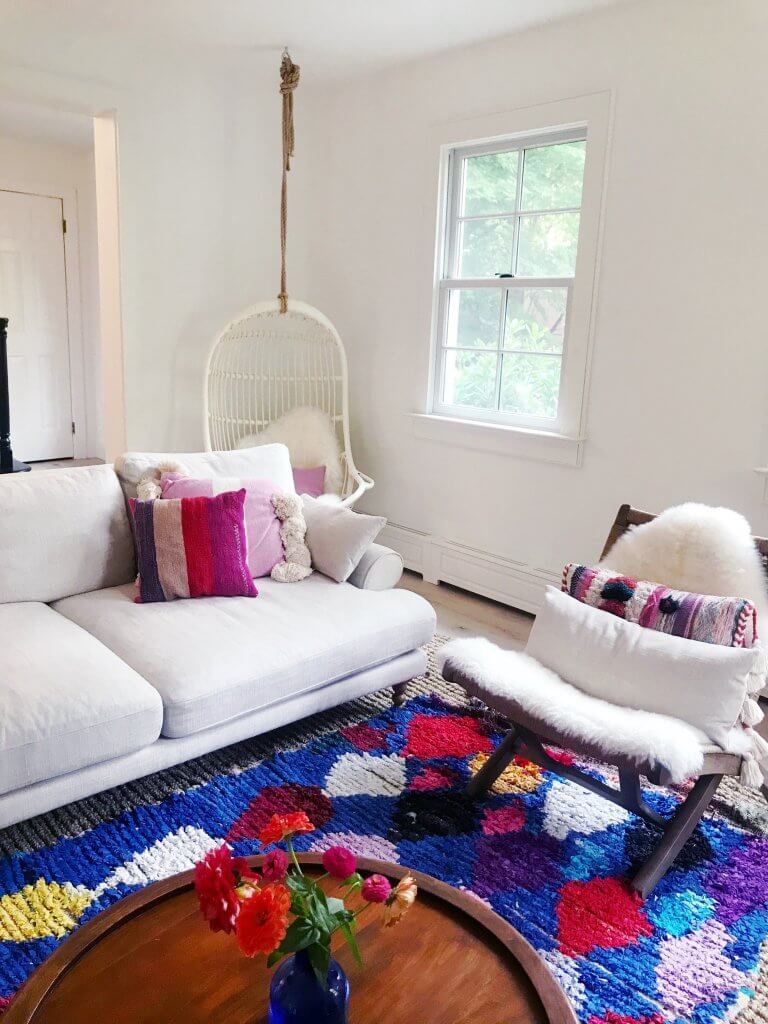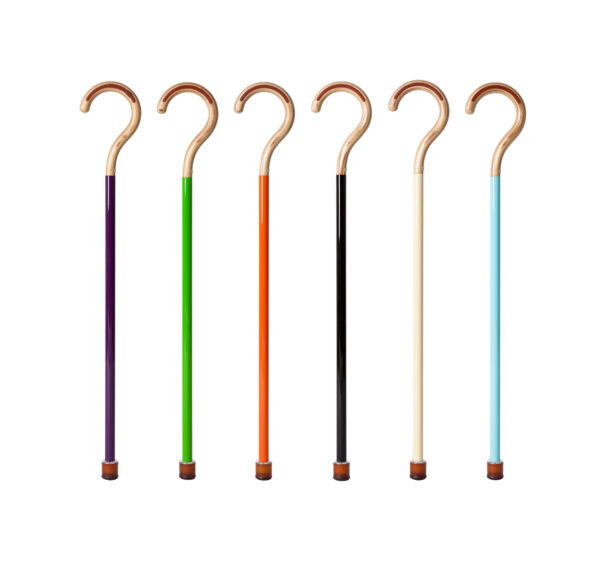One question that can help you create more joy at home — and in life

If you are looking to make a change in your home, sign-ups just opened for my free live workshop! We only host this popular offering once a year, so make sure you check our session schedule and save your seat ASAP.
These days, I’ve been thinking a lot about home. Part of this is personal. As I write this, I’m wrapping up a move out of the apartment my husband and I have lived in for the past five years, and we’re deep in execution mode on renovating our new place. Every day, it seems, we’re confronted with decisions about what to keep from our old home, and how to shape our new one. And through all of this, one thing has really hit home to me: The way we think and talk about home decor is broken.
If you’ve ever tried to decorate a room or renovate a home, you may have experienced something like this:
- You’re simultaneously excited by the opportunity to create something that’s truly yours, yet afraid of making a mistake.
- You’re presented with an overwhelming array of tiny details to choose from, from the shapes of knobs to fabric for the cushions to the color of the cabinets, without having any real framework for making a decision.
- Without knowing where else to start, you turn to images on the internet for inspiration, which all look a little too perfect (intimidating) and yet also look kind of the same as everything else that’s out there (because everyone else is also looking at the same images!).
- With each choice you make, you find yourself wondering, “Is this a good choice?” “Is it tasteful?” “Will it still be in style in five years?”
This is where it starts to go beyond me. Because if I’m feeling this sense of overwhelm, as a trained designer used to working with color and form, then I can’t be the only one. It’s like being on a tightrope, and you find yourself torn between playing it safe, getting something tried and true but boring, or taking a risk, worrying that won’t be worth the pain and expense if it doesn’t work out.
As I’ve gone through this seesaw of emotions, I realized: The entire process of home decor focuses on how our homes look. We almost never talk about how our homes feel.
We talk about whether homes are tasteful or tacky. We talk about whether they look current or dated. We talk about matte vs. satin vs. glossy. We talk about styles: modern or traditional, bohemian or industrial.
But in all this, we forget to ask the single most important question we can ask about our homes: How do I want my home to feel?
No wonder it feels hard to make decisions. Because without this question, all those little choices have no real meaning. Should you have round knobs or square knobs in your kitchen? Should you paint your dining room light blue or navy? Would you be happier with the roll-arm sofa in green velvet or the rattan one in pink linen? All of these things are just stuff until you know how you want your home to feel.
Emotions guide design. Whether we acknowledge them or not, our emotions are constantly helping us make decisions. Even when we think our choices are 100 percent rational, our emotions are sitting below the surface, steering the ship.
We know this because of an unusual case history shared by the neurologist Antonio Damasio in his book Descartes’ Error (and well-summarized here). Damasio recounts his work with a patient he calls Elliot, who developed a brain tumor in a part of the frontal lobe that relates to emotion. When Damasio met Elliot, he was intelligent and capable, yet he was struggling in almost every area of life. He lost his job, got involved in a moneymaking scheme with a scam artist that landed him in bankruptcy, got divorced, remarried, and then divorced again.
Elliot performed well on tests of cognition, such as language skills, memory, and math. But when he described the events of his (tragic) life, he couldn’t seem to feel anything. In fact, Damasio describes being more affected by the patient’s story than the patient himself. “He was always controlled, always describing scenes as a dispassionate, uninvolved spectator,” he writes. “Nowhere was there a sense of his own suffering, even though he was the protagonist.” And there was no empathy either. When Elliot viewed pictures of emotionally charged scenes, such as a building about to burn down, he could tell that he used to feel something, but didn’t anymore.
What does this have to do with decision-making? Well, what Damasio began to notice is that Elliot could come up with lots of options for what to do in a particular situation, but struggled to choose between them. What he realized is that when we make decisions, we get “good” and “bad” feelings about our options, which he calls somatic markers. Decisions involve gain and loss, and to most humans with an intact emotional brain, those particular consequences have emotional correlates. If we lose that capability, our decisions don’t feel like anything. And when they don’t feel like anything, it becomes almost impossible to choose. In Damasio’s words, a lack of emotion makes our “decision-making landscape hopelessly flat.”
I think the same thing happens to us when we think about our home as just a collection of stuff. All those little decisions become dissociated from the collective impact they have on our day-to-day lives. Taken individually, they seem small and inconsequential. But added up, they shape a space that feels like something, and often the result is not what we were craving at the outset. It might feel sophisticated when we wanted cozy, sedate when we wanted enlivened, lofty when we wanted playful. Or more often, it ends up feeling confused, reflecting our own confusion, or sterile, reflecting the fact that we followed the examples of others, but lost our own soul.
The problem, as happens in so many forms of decision-making, is that when we don’t ask “How do we want to feel?” we lack clarity. Knowing how you want to feel gives you a deeper framework that helps you understand on a visceral level what makes a decision good. Then all those little choices you have to make don’t just feel like arbitrary choices. They begin to feel like they’re bringing you closer to or further from what you really want.
In effect, emotions elucidate the why behind our decisions. I love Damasio’s framing of somatic markers for decision-making because it takes us out of our heads and puts us back in our bodies. What does it feel like to be in your home? (Or in your job, your relationship, your family?) What do you want it to feel like? Unlike the question, “How do you want your home to look?” these are not academic questions. They’re explicitly tied to the physical sensations you choose to surround yourself with. A truly joyful home always feels like something.
When I look back on the homes that truly felt like home to me, none of them were magazine-perfect. But they all had a clear and enveloping feeling. My Nana and Grandpa’s home, a light and airy apartment looking out over the Intracoastal Waterway, was like a permanent vacation. Decorated in pale pinks, peaches, blues, and yellows, it felt like being in a long summer sunset. My best friend Annie’s house felt playful, easygoing, informal. It was a vertical house, hugging big boulders on the side of a hill. There were two sets of carpeted stairs that we were always running up and down, a lofted bedroom, and a home office with a wall lined in skeins of embroidery thread in every possible color. It was never fancy or fusty, always the perfect house for a game of sardines.
Try this exercise with any home you’ve loved before, whether it was yours or belonged to someone else in your life. How did it feel? What made it feel that way? Chances are, it won’t be “perfect-looking,” but it will create a specific and memorable emotional signature, one that you can conjure up just by remembering the place.
When we stop seeing our homes as just a collection of stuff, we awaken to the possibility that they can be so much more. A truly joyful home can make it easier to live the life we truly want. It can reduce stress, make us more creative and connected, generous and energetic. If we know what we want from it, a joyful home can be the foundation of our wellbeing.
But we have to start by asking the question: How do you want your home to feel?
I’d love to know your answers to this question in the comments below.
And if you want to go deeper on creating a joyful home, I highly recommend checking out the new free resource I launched last week called the Joyful Home Assessment. This assessment walks you through nine more questions that can help you take stock of your home, identify joy-gaps, and prioritize simple steps that can help you create a home that feels just right to you. It’s completely free, and you can get it here.
Reminder: Sign ups for the 5 Secrets to Designing a Feelgood Home are now open! Check the schedule for this year’s free live workshop here.





Discussion (5 Comments)
Great post, Ingrid! When we looked for a house in CT (used to a lovely but dark and typically compact NYC apt), I had no preconceived notions. We spent many hilarious weekends looking and comparing notes on the drive back (That paint! Omg, the powder room! And so on). Then we entered this house and fell completely, intoxicatingly in love. The architect had planned everything but the way it made me feel…was as if the house wrapped me in its arms. Impractical, too expensive, and the most wonderful home I’ve ever had – no regrets ;)! So, my takeaway is to let your heart lead … ?
I love that – as if the house wrapped you in its arms. Yes to that feeling!!!
Hi Ingrid,
Thanks for this lovely post! I never really thought about how I wanted my home to feel until I read this, but since I started your book (gorgeous read, btw!), I’ve been making tiny tweaks around the house.
I want my home to feel like a bright, spacious haven of love, joy, and beauty. Lots of light, vibrant colours that plump up my heart, and delightful art that inspires the artist in me.
I’m slowly living out that vision by switching things up one teeny step at a time. I’ve been decluttering and reorganising (so fun!), tossing out ugly stuff, and only buying things I really, really love. I’m excited to see how it unfurls! 🙂
This is really interesting and timely; as a psychologist, it makes so much sense! I’ve been incredibly frustrated around decorating the new (to me, long-occupied by my boyfriend) home I’ve been in for a year. I had a beautiful little 1921 Craftsman, all my own, decorated in a period appropriate style, and I am SO LOST now. But I think focusing less on specific objects and more on the feelings will be very helpful.
A quilter, mad for most colors, it was tough when the house was done over. I couldn’t pick paint colors to save my life, too many options. I hired a “Done In A Day” person to come over. She looked at what things I had, and suggested several color palettes, No, No, No, Shazam! Perfect! I had the rooms painted the colors from Shazam pick. Next, another “Done In A Day” person, a coworker came over. Asked what I do in the living room, and said buy a book case about this color, about this size, and call me when it comes in. When it was in, came over, she kicked me out of the house, and rang the cell phone when I could come back. I LOVE LOVE LOVE this room. The color says Welcome Home Sweetheart, and the furniture, pictures, etc. look like they were made for the room (she selects from what you already own). She said people already know what they like, most just have them in the wrong place.
I’d still have no talent to do what they did, but love that they did it for me. I hope something in this helps you, Gretchen.